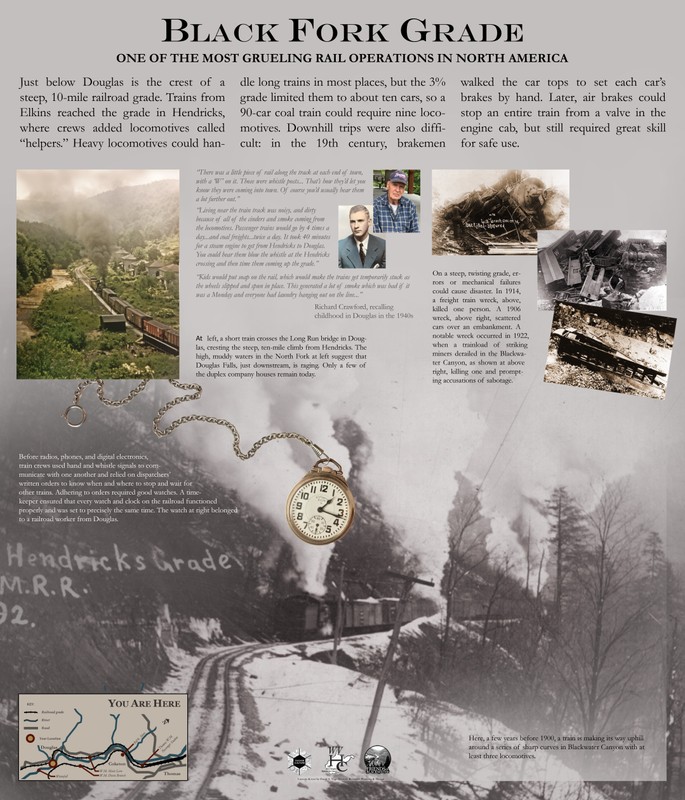Black Fork Grade
Introduction
Text-to-speech Audio
This uniquely steep grade on the former West Virginia Central and Pittsburg Railroad, later the Western Maryland Railway, is located just past the location of a rail bridge and demonstrates the obstacles faced in transporting coal and other goods in this part of West Virginia. Few rail routes required more machinery or personnel to keep coal moving up the Blackwater Canyon grade. To get a loaded, 90-car coal train up to Douglas and into Thomas, it took nine locomotives to pull the coal hopper cars up the 3% grade of the Blackwater Canyon. Downhill trips were also difficult: in the 19th century, brakemen walked the car tops to set each car’s brakes by hand. Later, air brakes could stop an entire train from a valve in the engine cab, but still required great skill for safe use.
Images
This sign sharing the history of Black Fork Grade has made by the Friends of Blackwater organization.

Backstory and Context
Text-to-speech Audio
So prior to the 1870s, in West Virginia, there were a few key trunk routes for transportation across the state; a place where roads and railroads could follow rivers, and the passages were relatively easy, but most of the interior of the state— the geography, was rough enough to limit how you can get in and out. And that changed as the technology for earthmoving started to come into its own in the late 19th century. That enabled people, like Henry Gassaway Davis, to build railroads into places like Thomas and Coketon and the community where we’re standing now, Douglas, mine coal and haul it out to market. All from this area to steel mills in Pittsburgh and Baltimore, it went to heating fuel distributors all along the railroad routes of the northeast and the Midwest, and it went to ports— like the port of Baltimore— for overseas shipment. This was one of the toughest railroads to operate anywhere in the eastern United States and, to an extent, anywhere in North America. We’re standing at a point in Douglasville, which is about a mile from the top of, what was known for a long time as, the Blackwater grade. It’s still called that by many people, but it was a very steep, curving railroad operation that pushed the trains of the West Virginia Central & Pittsburgh Railroad— later the Western Maryland Railroad— right to their limits. So trains coming up from Hendricks at the bottom of the hill about ten miles away, would top the grade here, and the grade was so steep that for every ten cars of coal, you had to add another locomotive. So a 50 car coal train, or a 90 car coal train, would require a locomotive for every 10 cars. For the folks that we talked to today remember life in Douglas, one of the defining characteristics was being able to give those trains, coming up from miles away up the canyon, and the presence of the noise and the smoke that filled the valley as trains passed through. Just a few miles up in Coketon, between here and Coketon, the locomotives would cut off and then a single locomotive, or a pair of locomotives, to continue on the easier more-level track. But the Blackwater Canyon grade of the Western Maryland was very well-known among people, among professional railroad workers, around the eastern United States because it’s such an exceptionally difficult piece of railroad to operate, but that intensiveness of machinery and equipment, the amount of infrastructure that it took, and the amount of workforce that it took to keep that going illustrates to no small extent, just how valuable the coal was in this part of West Virginia. The volume of coal that was being shipped out, and its usefulness to industry and home heating, and its value as a consumer product between the 1880s and the 1950s, speaks to the amount of money that the companies invested in building the infrastructure required to extract coal and other resources.
Cite This Entry
Admin, Clio, Alicia Erjavec, and Judith S. Rodd on behalf of Friends of Blackwater, Inc. "Black Fork Grade." Clio: Your Guide to History. May 26, 2022. Accessed April 2, 2025. https://theclio.com/entry/113785

